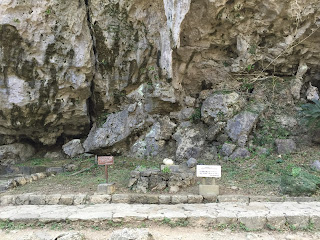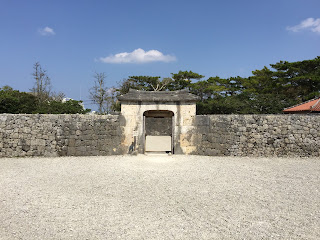ガジュマルの森を抜けると、一気に視界が開けて、大きな池や建物が見えてくる。
池は心字池だが、沖縄らしい石垣が多く使われていて、池の中に建てられている中国風の六角堂などもあり、中国と日本の間に位置している沖縄をよく表している庭園になっている。
現在の見学者は、石段を歩いて六角堂や御殿をめぐるが、冊封使はこの池を船で渡って、風景をのんびりと眺めながら、御殿に向かったようだ。
この識名園は、第二尚氏王朝の18世紀中頃から建設が始まり、18世紀の終わり、1799年に完成した。
この時代は、琉球王朝文化の最盛期と言われていて、中国系の蔡温という、琉球王国氏の中でも屈指の政治家が、三司官という宰相職についていた時代でもあった。
もしかしたら、蔡温もこの識名園の建設に関係していたかもしれない。
また、この18世紀という時代は、清では乾隆帝が1735年から1796年のおよそ60年もの長きにわたり皇帝として支配し、清の最盛期でもあった。
徳川幕府が統治する日本では、逆に危機の時代だった。江戸時代初期の年貢の増加が止まり、田沼意次の経済改革が行われていた。
識名園の一角には、那覇市内から遠方を見渡せる、観耕台がある。
清からの冊封使を接待した琉球王国の役人は、ここに冊封使を案内し、琉球王国には青い海ばかりでなく、広大な緑の耕作地が広がり、農作物も豊富であることをアピールした。
中国や日本の屏風絵に、四季耕作図という画題があるが、この観耕台からの風景は、かつては四季耕作図そのものだったのだろう。
残念ながら、現代の琉球の風景は、耕作地より、人々の暮らすマンションの方が、この観耕台からはよく見える。
When you exit the forest of banyan, at once sight is opened, a large pond and the building comes into view.
Pond's Shinjiike but, Okinawa seems to have been stone wall is frequently used, there is also such as built in are Chinese-style Rokkakudo in the pond, in China and well represent to have garden Okinawa, which is located between Japan ringing are.
The current visitors, but over Rokkakudo and palace to walk the stone steps, Sakufu-shi is across the pond by boat, while leisurely admiring the landscape, seems headed to the palace.
This Shikinaen Garden, construction from the 18th century the middle of the second still Mr. dynasty began, and the end of the 18th century, was completed in 1799.
This era, and it has been said to be the golden age of the Ryukyu dynasty culture, that Saion of Chinese, politicians of leading Among Mr. Ryukyu kingdom, was also the era had been attached to the prime minister positions that Sanshikan.
Maybe then, Saion also may have been involved in the construction of this shikina-en.
In addition, the era of the 18th century, ruled as a long time over the emperor also about 60 years from the Emperor Qianlong of 1735 of 1796 in the Qing, was also the Qing heyday.
In Japan, the Tokugawa shogunate rule, it was the age of the crisis in reverse. It stops increase of the early Edo period of the annual tribute, Tanuma Okitsugu of economic reform has been carried out.
The corner of shikina-en, overlooking the distant from Naha city, there is a Miko stand.
Officials of the Ryukyu Kingdom was entertain Saku seal used from Qing, here to guide the Sakufu use, not only blue sea in the Ryukyu Kingdom, the vast green of the arable land is spread, appealed that the crop is also abundant .
China and Japan of folding screen picture, but there is a motive that the four seasons farming view, the scenery from the can hydroponic bench, probably was once a four seasons cultivation diagram itself.
Unfortunately, modern Ryukyu of landscape, from the cultivated land, is more of apartment classes of people, looks good from the can hydroponics stand.
(Translated by Google Translate)

















































